| ← back |
Colonial Meetinghouses Featured in this Project |
next → |
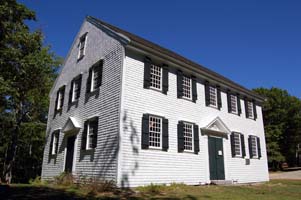 Name of Meetinghouse: Old Walpole Meetinghouse
Name of Meetinghouse: Old Walpole Meetinghouse
View on a mapStreet Address of Meetinghouse: Meetinghouse Road, Bristol, ME (just east of intersection with Route 129, which in turn is about 1/4 mile south of the intersection of Routes 129 and 130)Year(s) Built: 1772 National Register of Historic Places Designation: yes Maine State Register of Historic Places: ? Organization responsible: Old Walpole Meetinghouse Corporation Organization's address: Treasurer Fred Bowers, PO Box 581, Wiscasset, ME 04578 Organization's web site: none yet Town web site: Town of South Bristol, Maine Nearby town web site: Town of Bristol, Maine Tax status: 501 (c)(3) tax exempt Contact (Events and Weddings): Deb Storch, 135 State Route 129, Walpole, Maine 04573 Telephone: (207) 563-7050 E-mail: none Alternate Contact: Ken Smith, 240 Foster Road, Round Pond, ME 04564 Telephone: 207-677-6560 (home) E-mail: orr1957@gmail.com This page was last modified on: Dec 02, 2011 Acknowledgements: The text below is taken in part from a pamphlet prepared by the Old Walpole Meetinghouse Corporation, and has been used by permission. Additional text is taken from Eva Speare's 1938 book Colonial Meeting-Houses of New Hampshire.
This historic meetinghouse at the head of South Bristol Peninsula stands today in its original form, appearing virtually as it did to our forbearers. While at the outset the Old Walpole Meetinghouse was Presbyterian in denomination, its distance from Boston, where the Presbytery met, was so great that it became subsequently a Congregational Church. (The Congregational headquarters have always been in Portland, Maine).
Especially interesting is the paneled balcony, which was prepared for the servants, who also attended worship upstairs. These fine old panels are boards 30 inches in width, surprising because the King's men had marked all trees over 21" in diameter to be saved for masts for the Royal Navy.
For 236 years, from the day when this meeting house was dedicated down to the present time,
there was and always has been a Deacon Hunter presiding over the affairs of this ancient House of God and town meeting place.
Unlike the other surviving meetinghouses which are typically clad with clapboards, the exterior of Walpole's meetinghouse is covered by rough, hand-split shingles that, once upon a time, were either painted or stained a brownish yellow that so resembles the color of the birch leaves as to camouflage it among the trees. In size and shape, Walpole resembles its contemporary, Sandown; even the arrangement of the pews on the floor is identical also. Here, however is a more completely finished interior. The rough posts of the frame are concealed by planed casement with beveled corners; the woodwork is painted a dull grey color; the windows are furnished with twenty-four of the smallest panes of old glass that we have seen.
A reversed plan for the pews was found in the gallery. On its floor the square pews lined the parapet while the usual long slip pews were built on raised step-like platforms behind the family pews. Balancing upon the railing of the rear pew, we were able to lift our heads through the cubbyhole in the ceiling to study the framework of the roof. To our surprise, the timbers were about half the size of other structures of this period and queen-post trusses with single rafters supported the roof. As in Sandown, the wedged or "locked" joints held the struts firmly in position. |
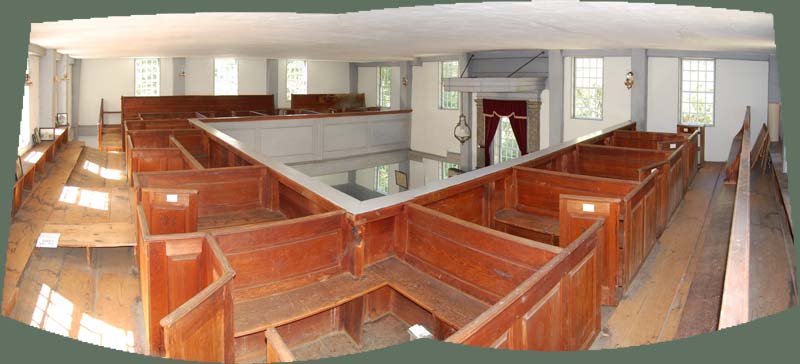
|
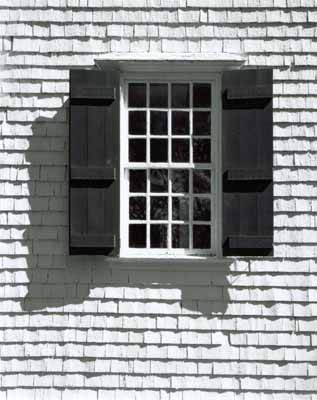
|
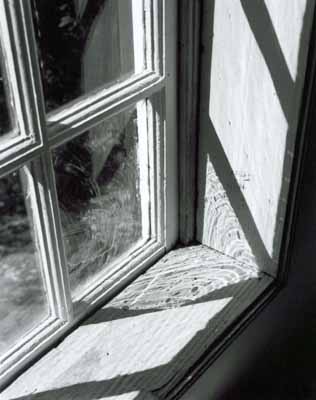
|
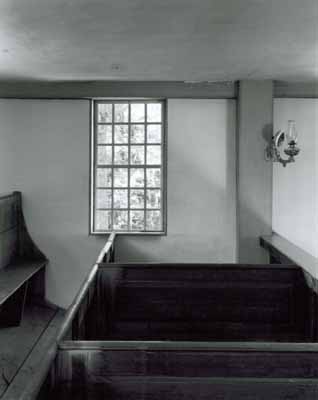
|
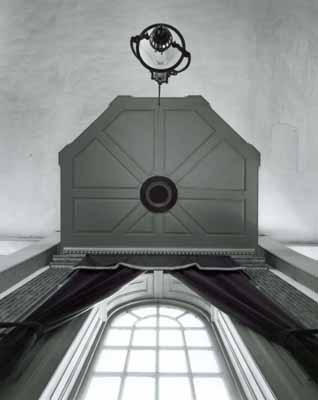
|
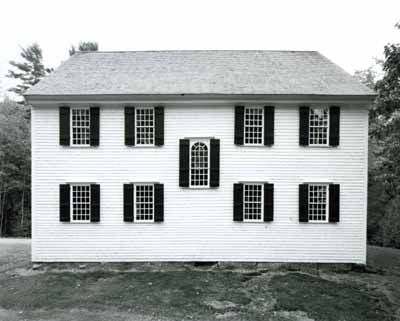
|
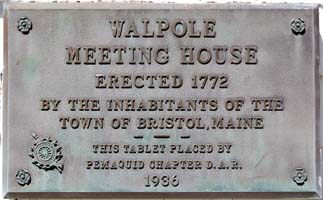 Built in 1772, the meetinghouse at Walpole, Maine is nearly identical to the one in Sandown, NH,
which was built a year or so later.
Even the arrangement of the pews is identical.
I am always amazed that in the 18th century, in a time
of difficult travel or communication even between near-by towns,
the meetinghouses of communities all across New England were so similar.
One difference with Walpole, however, is that the Walpole meetinghouse is clad in shingles (painted white)
instead of the quintessential New England clapboards.
Built in 1772, the meetinghouse at Walpole, Maine is nearly identical to the one in Sandown, NH,
which was built a year or so later.
Even the arrangement of the pews is identical.
I am always amazed that in the 18th century, in a time
of difficult travel or communication even between near-by towns,
the meetinghouses of communities all across New England were so similar.
One difference with Walpole, however, is that the Walpole meetinghouse is clad in shingles (painted white)
instead of the quintessential New England clapboards.
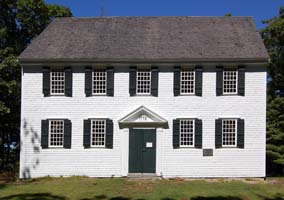 The original hand-shaved shingles are still on the walls of the edifice.
When, in 1872, extensive repairs (not remodeling) of the structure were undertaken,
the shingles were found to be so far superior to modern shingles that it was decided not to disturb them.
Nails and hinges throughout the building were all handmade.
The windows were easily the most expensive parts of the building, since they were imported from England;
each window is said to have cost the price of one cow.
The original hand-shaved shingles are still on the walls of the edifice.
When, in 1872, extensive repairs (not remodeling) of the structure were undertaken,
the shingles were found to be so far superior to modern shingles that it was decided not to disturb them.
Nails and hinges throughout the building were all handmade.
The windows were easily the most expensive parts of the building, since they were imported from England;
each window is said to have cost the price of one cow.
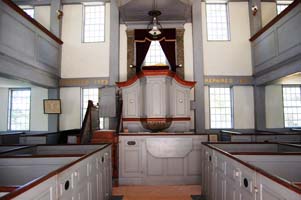 In her 1938 book, Eva Speae has this to say about Walpole's meetinghouse:
In her 1938 book, Eva Speae has this to say about Walpole's meetinghouse:
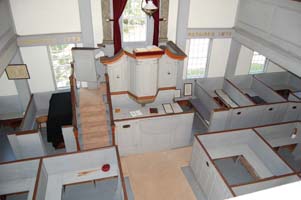 The pulpit is a masterpiece by skilled ship carpenters and unlike any design elsewhere.
If the tulip base designates the pattern of Rocky Hill,
then the daisy must have been the inspiration for this one in Walpole.
A mottled green paint, to simulate Italian marble, covers both the pulpit and the posts that support the gallery.
One of the most curious relics we have found is the hinge to the door that enters the pulpit pew.
A double jointed semi-circular section permits the door to slip by into the pulpit enclosure a few inches so, as it swings,
it does not obstruct the narrow landing at the top of the stairway.
The pulpit is a masterpiece by skilled ship carpenters and unlike any design elsewhere.
If the tulip base designates the pattern of Rocky Hill,
then the daisy must have been the inspiration for this one in Walpole.
A mottled green paint, to simulate Italian marble, covers both the pulpit and the posts that support the gallery.
One of the most curious relics we have found is the hinge to the door that enters the pulpit pew.
A double jointed semi-circular section permits the door to slip by into the pulpit enclosure a few inches so, as it swings,
it does not obstruct the narrow landing at the top of the stairway.